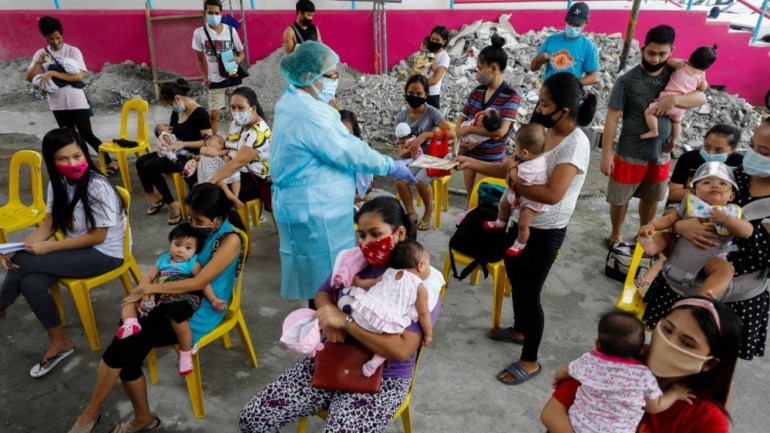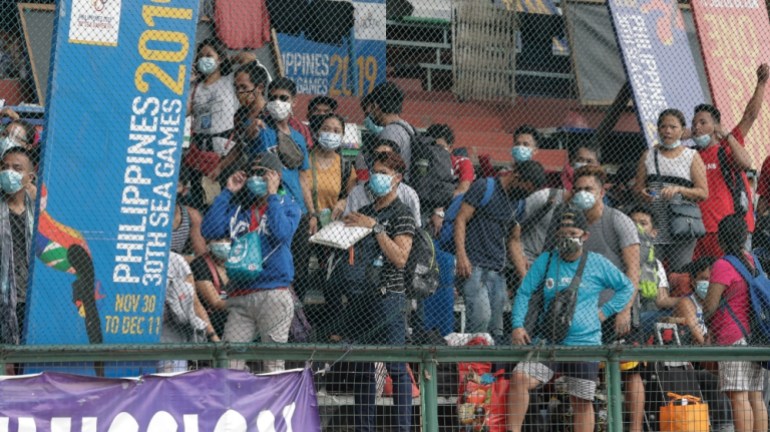Duterte pledged a COVID-free Christmas. Instead, cases soar
Millions of Filipinos attend Christmas events in spite of the president’s warnings that these gatherings could drive up community transmission.

Mindanao, Philippines – Shouting at the top of their lungs, more than a thousand residents of Polanco, a small town in the southern Philippines, stood shoulder-to-shoulder at a local park earlier this month to join a Christmas tree-lighting countdown, defying the national government’s social-distancing guidelines.
Some people were not wearing masks while children who are banned from mass gatherings due to the risk of infection, ran around.
Keep reading
list of 3 itemsDuterte volunteers for trial of Russian coronavirus vaccine
Duterte wants government-to-government deal for COVID-19 vaccines
The police stood helpless in the middle of the crowd as politicians allied with President Rodrigo Duterte led the ceremony.
Days later, many of the same residents, gathered anew at a church nearby to join the nationwide “Simbang Gabi” – a series of nine nightly rituals commemorating Christ’s birth. Inside, social-distancing protocols were difficult to observe.
Such scenes have been repeated all over the predominantly Catholic nation in the run up to Christmas, which falls on Friday. Amid the threat of the pandemic many of the Philippines’ 86-million faithful are insistent on maintaining a 350-year-old religious tradition that dates back to the Spanish era, and is celebrated in a carnival of festivities that start in September.
Not far from Polanco’s town centre the cockfighting arena is back in business.
After months of lockdown, authorities have allowed it to reopen, attracting crowds of mostly male gamblers. Health protocols are imposed indoors but it is unclear how strictly the rules are enforced there or in similar venues across the country, as spectators routinely shout out their bets, which can be up to hundreds of dollars as they watch the roosters fight to the death.
While it is difficult to establish a direct link between specific events and locations to the rising COVID-19 infections, Philippine health experts say a surge in new cases is “most likely” associated with holiday crowds as well as looser health regulations at the local community level.
At the height of the coronavirus lockdown in July, Duterte issued a stern warning to local officials to strictly adhere to the national guidelines against the pandemic. He even urged authorities to shoot lockdown violators. He also said that by December, the country would be “back to normal” with vaccines made available from China.
But in 285 days since he ordered a lockdown, Duterte’s bluster now appears empty, with none of the vaccines he touted approved by regulators and a new wave of transmission emerging. Even his pledge that he would volunteer to be part of Russia’s vaccine trial has not materialised and local communities from his hometown in Mindanao have been seen openly flouting his orders as they celebrate the Philippines’ most important religious festival of the year.
Sec. Duque is busy doing photo op rounds with a ruler for social distancing measures , while the rest of the world is busy vaccinating their people. Talking about strategic planning and big picture thinking. That’s why we have the longest lockdown on earth. https://t.co/qyzl9ON6Y2
— Tony Leachon MD (@DrTonyLeachon) December 23, 2020
COVID-19 reproduction rate up
On Tuesday, Octa Research, a group of Filipino experts monitoring COVID-19 cases, warned of a new surge of infections in the capital Manila, with the reproduction rate increasing from 1.06 to 1.15 and beyond.
“It is in this light that we believe, based on our analysis of the data and of the past trends in the NCR (National Capital Region) that a surge in its early stages has already started in the region. This is a serious cause for concern,” the research firm said.
Seven provinces across the country are also seeing a spike, it added, urging the government to “intensify their efforts at testing, tracing, and isolation” to reverse the trend.

The group urged the national and local governments to strictly enforce health protocols and discourage mass gatherings to curb the outbreak. It also alerted the government to increase healthcare capacity as soon as possible.
As of 08:00 GMT on Wednesday, coronavirus deaths in the Philippines have exceeded 9,000, with more than 464,000 cases, of which almost 430,000 have reportedly recovered.
Dr Butch Ong of Octa Research said in a virtual press conference on Wednesday that with the current trend it was likely that infections would reach 500,000 within days.
He appealed to Filipinos to adhere to health-safety measures in their communities.
A surge in COVID-19 cases is in its early stages in Metro Manila particularly in cities from the northern part of the capital region, experts said Wednesday. | @DJEsguerraINQ https://t.co/bSNmh9IPVO
— Inquirer (@inquirerdotnet) December 23, 2020
Health Secretary Francisco Duque also repeated his appeal on Wednesday to Filipinos to observe minimum health protection standards to prevent the expected surge.
But his latest message was met with public scorn after he openly feuded with Foreign Secretary Teodoro Locsin, who accused him of “dropping the ball” in the delayed negotiations to procure at least 10 million doses of the Pfizer vaccine by early 2021.
Upward trend feared
Dr Joey Hernandez, a medical doctor study who is pursuing further biostatistics study at Johns Hopkins University, told Al Jazeera that researchers noticed the increase in cases in the country as early as mid-December.
Hernandez, who himself contracted COVID-19 in Manila last March, said that it was “most likely” that the spike in new cases was linked to holiday crowds, as well as more relaxed lockdown regulations.
With no major announcements about stricter guidelines expected in the coming days or a vaccine roll-out imminent, it was likely that the upward trend will continue, he added.
Dr Raymond Naguit, a medical expert and chairperson of the progressive party, Akbayan Youth, told Al Jazeera that it was already “quite scary to imagine” what cases would be like after December.
“Christmas season is known to be a time where Filipinos gather, shop, and celebrate,” he said, noting that while the festivities this year may not be as crowded as in previous years, the “seemingly harmless gatherings” of friends and family members could still spread the virus.
A daily average of 4,000 new cases is classified as critical by Filipino health experts. The current numbers hover between 1,000 and 2,000 daily confirmed cases.
That means the current pace is still manageable and has not yet reached a point that could potentially overwhelm the health system, Naguit explained.
Still, the statistics should be approached with caution, he said, as each hospital and region may collate the figures differently.
Impact on health workers
As it is, Naguit said, based on his conversations with other health workers, the pandemic has already taken a serious physical and emotional toll on the profession.
“Some of them already consider changing careers completely while some young health professionals consider postponing their entry into the workplace,” he said.
On top of this, health workers generally feel that they are being exploited, with many being overworked and underpaid.
Japeth Dayahan is a senior nurse at a government health facility in the central island of Negros. She says that because the hospital where she works is understaffed, they have had to extend the nurses’ shifts to accommodate the rising number of patients.

“We did not foresee this problem,” she said. “We also have to have enough budget for the hospitals.”
This Christmas season, she says she is praying for the healing of her COVID-19 patients and for the killings in Negros to stop, noting the recent murder of a city health doctor, who was leading her community’s anti-pandemic medical response.
With little sign of a vaccine being widely distributed in the Philippines – the government says it is “still in negotiations” with manufacturers – Naguit of Akbayan Youth, says the further increase in cases is a “likely possibility”.
“I just hope the government is prepared for possible surges and be ready to enforce tighter measures while ensuring that basic needs of the people are met,” he said.
As for Ray Pagulong, a Catholic devotee from Surigao in the eastern part of Mindanao, not even the threat of a potentially deadly virus can stop him from attending the nine days of prayers that culminate in a mass gathering in his church on the eve of Christmas on Thursday night.
“In my church we adhere to social distancing, proper sanitation and even checking of body temperature,” he told Al Jazeera.
“It has always been my promise to complete the nine days of prayer, because it is my way of expressing my utmost thanks to God,” the former overseas Filipino worker added. Aside from the pandemic, his family also had to contend with flooding in their home due to a recent typhoon.
“This advent season somehow is a reminder to myself that we have to reflect and prepare ourselves for the coming of God.”